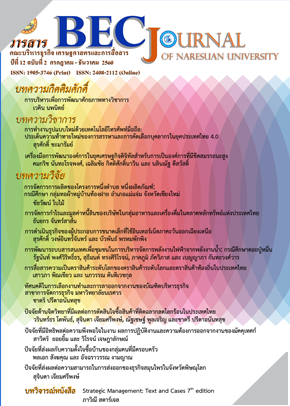ปัจจัยที่ส่งผลต่อความสามารถในการส่งออกของธุรกิจสมุนไพรในจังหวัดพิษณุโลก
Main Article Content
บทคัดย่อ
ปัจจุบัน ความต้องการส่งออกสมุนไพรเพิ่มสูงขึ้น ทำให้ประเทศมีรายได้จากการส่งออกกว่า 100 พันล้านบาทในปี พ.ศ. 2559 โดยเฉพาะในกลุ่มอาหารเสริม สปาและผลิตภัณฑ์ยาแผนโบราณ แต่มูลค่าการนำเข้ามีแนวโน้มสูงกว่ามูลค่าการส่งออกทุกปี ดังนั้น ความจำเป็นที่ต้องพัฒนาความสามารถส่งออกให้เพิ่มขึ้น เพื่อสร้างรายได้ และความเข้มแข็งให้ธุรกิจจนสามารถแข่งขันได้ ตลอดจนมีศักยภาพในการส่งออกจึงสำคัญ อย่างไรก็ตาม ธุรกิจสมุนไพรส่วนใหญ่เป็นธุรกิจขนาดกลางและขนาดเล็ก มักประสบปัญหาต่างๆ เช่น ปัญหาการผลิตที่ไม่ได้คุณภาพสากล ปริมาณการผลิตไม่พอต่อความต้องการของตลาด ต้นทุนสูง ตลอดจนปัญหาเทคนิคการผลิต การบริหารจัดการและการตลาด เป็นต้น งานวิจัยนี้ ได้ทำการศึกษาปัจจัยที่ส่งผลต่อความสามารถในการส่งออกของธุรกิจสมุนไพรขนาดเล็กและขนาดกลางจำนวน 33 ราย ในจังหวัดพิษณุโลก โดยมีคำถามวิจัย คือ 1) ศักยภาพทางการตลาดและโอกาสของธุรกิจผลิตภัณฑ์จากสมุนไพร เพื่อการส่งออกในจังหวัดพิษณุโลกเป็นอย่างไร 2) ปัจจัยที่ส่งผลสำเร็จต่อธุรกิจส่งออกผลิตภัณฑ์สมุนไพรในพิษณุโลกคืออะไร ผลการศึกษาพบว่า ปัจจัยภายใน ได้แก่ สภาวะปัจจัยการผลิต โครงสร้างองค์กร สภาพอุปสงค์ อยู่ในระดับมาก สำหรับปัจจัยภายนอก พบว่า สภาพแวดล้อมทางการเมืองและทางสังคมอยู่ในระดับมาก ส่วนศักยภาพในการส่งออกของพิษณุโลกนั้นอยู่ในระดับสูง ปัจจัยที่ส่งผลสำเร็จต่อธุรกิจส่งออกผลิตภัณฑ์สมุนไพรในพิษณุโลก คือ ความสามารถในการแข่งขันอยู่ในระดับมาก ความสามารถด้านผลิตภัณฑ์ ความสามารถด้านราคา ความสามารถด้านช่องทางการจำหน่าย และกระจายและส่งสินค้าดีกว่าคู่แข่ง
Article Details
เอกสารอ้างอิง
2. Analoui, F. (2007). Strategic Human resource management. London: Thomson Learning.
3. Barney, J. (1991). Firm resources and sustained comparative advantage. Journal of management, 17(1), 99-120.
4. Cavusgil, S. T. and Naor, J. (1987). Firm and management characteristics as discriminators of export marketing activity. Journal of Business Research, 15(3), 221-235.
5. Cavusgil, T. and Zou, S. (1994). Marketing Strategy-performance relationship: An investigation. Journal of Marketing, 58(1), 1-21.
6. Chetty, S. K. and Hamilton, R. T. (1993). Firm-level determinants of export performance: A meta-analysis. International Marketing Review, 10(3), 26-34.
7. Chemsripong, S. (2012). Capacity building program linking quality agricultural and agricultural marketing. Phitsanulok: Phitsanulok City Hall.
8. Chemsripong, S. (2014). The project supports the standardization of goods and services of the provinces to build competitiveness and create value added products. Phitsanulok: Naresuan University.
9. Christensen, C. H., da Rocha, A. and Gertner, R. K. (1987). An empirical investigation of the factors influencing exporting success of Brazilian firms. Journal of international Business studies, 18(3), 61-77.
10. Culpan, R. (1989). Export behavior of firms: Rlvance of firm size. Journal of Business Research, 18(3), 207-218.
11. Department of Thai Traditional and Alternative Medicine. (2013). Thailand champion herbal products. Bangkok: Ministry of public health.
12. Department of International Trade Promotion Ministry of Commerce. (2013). Thai herbs for export. Bangkok: Ministry of Commerce.
13. Dijik, M. V. (2002). The determinants of export performance in developing countries: The case of Indonesian Manufacturing. Eindhoven: Eindhoven Centre for Innovation Studies.
14. Julian, C. C. (2003). Export marketing performance: A study of Thailand Firms. Journal of Small Business Management, 41(2), 213-221.
15. Kaynak, E. and Kuan, W. Y. (1993). Environment, strategy, structure, and performance in the context of export activities: An empirical study of Taiwaneses manufacturing firms. Journal of Business Research, 27(1), 33-49.
16. Katsikea, E. S. and Skarmeas, D. A. (2003). Organisational and managerial drivers of effective export sales organizations. European Journal of Marketing, 37(11/12), 1723-1745.
17. Leonidou, L. C., Katsikeas, C. S. and Samieec, S. (2002). Marketing strategy determinants of export performance: A mete-analysis. Journal of Business research, 55(1), 51-67.
18. Madsen, T. K. (1989). Successful Export Marketing Management: Some empirical evidence. International Marketing Review, 6(4), 41-57.
19. Mooney, A. (2007). Core competence, distinctive competence and competitive advantage: What is the difference?. Journal of Education for Business. 82(2), 110-115.
20. National Innovation Agency. (2016). Thai herbal products report. Bangkok: National Innovation Agency publisher.
21. Porter, M. E. (1985). Competitive advantage: Creating and sustaining superior performance. New York: The Free Press.
22. Porter, M. E. (1990). The Comparative Advantage of Nations. New York: Free Press.
23. Porter, M. E. (1998). The Adam smith address: Location, clusters, and the new microeconomics of competition. Business Economics, 3(1), 1-7.
24. Porter, M. E. (1998). The Competitive Advantage of Nations. New York: MacMillan.
25. Porter, M. E. and Ketels, C. H. M. (2003). UK Competitiveness: Moving to the next stage. UK: DTI Economics paper.
26. Shoham, A. (1996). Marketing-mix standardization: Determinants of export performance. Journal of Global Marketing, 10(2), 53-73.
27. Shoham, A. (1998). Export Performance: A Conceptualization and Empirical Assessment. Haifa: University of Haifa.
Sousa, C. M. P. (2004). Export performance measurement: An evaluation of empirical research in the literature. Academy of Marketing Science Review. 9(1), 1-22.
28. Tesfom, G. and Lutz, E. (2006). A classification of export marketing problems of small medium sized manufacturing firms in developing countries. International journal of Emerging Markets, 1(3), 262-284.
29. Zou, S. and Stan, S. (1998). The determinants of export performance: A review of the empirical literature between 1987and 1997. International Marketing Review, 15(5), 333-356.


